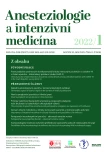-
Medical journals
- Career
Butyrylcholinesterase deficiency or “I remember intubation”
Authors: D. Novotný 1,3; J. Závada 2; M. Novotná 3; A. Bočková 3; T. Vymazal 4
Authors‘ workplace: Klinika anesteziologie, resuscitace a intenzivní medicíny 1. lékařské fakulty Univerzity Karlovy a Ústřední vojenské nemocnice Praha 1; Klinika anesteziologie, resuscitace a intenzivní medicíny 1. lékařské fakulty Univerzity Karlovy a Všeobecné fakultní nemocnice Praha 2; VUAB Pharma, a. s., Roztoky 3; Klinika anesteziologie, resuscitace a intenzivní medicíny 2. lékařské fakulty Univerzity Karlovy a Fakultní nemocnice Motol Praha 4
Published in: Anest. intenziv. Med., 33, 2022, č. 1, s. 51-54
Category: Case Reports
Overview
This case report describes a patient with a personal history of muscle paralysis after emergence from a short general anaesthesia with the use of suxamethonium. She has a partial recall of subsequent intubation. After a few hours of mechanical ventilation and sedation, she was extubated without complication in the ICU. During the preanesthesia evaluation, we suspected a deficiency of butyrylcholinesterase, an enzyme metabolizing mivacurium and suxamethonium. Due to that, general anaesthesia with muscle relaxation using rocuronium was performed for a planned hemithyreoidectomy. There were no complications during the surgery and subsequent genetic examinations revealed a combined mutation of the butyrylcholinesterase gene. Butyrylcholinesterase deficits increase the risk of perioperative respiratory complications. Testing of family members of patients with a confirmed mutation or preventive preoperative examination in high-risk surgery prevent such complications.
Keywords:
Apnea – Inborn errors of metabolism – suxamethonium – mivacurium – butyrylcholinesterase deficiency – neuromuscular monitoring
Sources
1. Soliday FK, Conley YP, Henker R. Pseudocholinesterase deficiency: a comprehensive review of genetic, acquired, and drug influences. AANA J. 2010;78(4):313-320.
2. Andersson ML, Møller AM, Wildgaard K. Butyrylcholinesterase deficiency and its clinical importance in anaesthesia: a systematic review. Anaesthesia. 2019;74(4):518-528. doi: 10.1111/anae.14545.
3. Thomsen JL, Nielsen CV, Palmqvist DF, Gätke MR. Premature awakening and underuse of neuromuscular monitoring in a registry of patients with butyrylcholinesterase deficiency. Br J Anaesth. 2015 Jul;115 Suppl 1:i89–i94. doi: 10.1093/bja/aev103.
4. Vickers MD. The mismanagement of suxamethonium apnoea. Br J Anaesth. 1963;35 : 260-268. doi: 10.1093/bja/35. 4. 260.
5. Tran DT, Newton EK, Mount VA, Lee JS, Wells GA, Perry JJ. Rocuronium versus succinylcholine for rapid sequence induction intubation. Cochrane Database Syst Rev. 2015 Oct 29;2015(10): CD002788. doi: 10.1002/14651858.CD002788.pub3.
6. Vymazal T, Krecmerova M, Bicek V, Lischke R. Feasibility of full and rapid neuromuscular blockade recovery with sugammadex in myasthenia gravis patiens undergoing surgery – the serie of 117 cases. Ther Clin Risk Manag. 2015 Oct 15;11 : 1593-1596. doi: 10.2147/TCRM.S93009.
7. Frerk C, Mitchell VS, McNarry AF, Mendonca C, Bhagrath R, Patel A, et al.; Difficult Airway Society intubation guidelines working group. Difficult Airway Society 2015 guidelines for management of unanticipated difficult intubation in adults. Br J Anaesth. 2015 Dec;115(6):827-848. doi: 10.1093/bja/aev371.
8. Adamus M, Cvachovec K, Černý V, Herold I, Horáček M, Mach D, et al. Doporučený postup ČSARIM: Zásady bezpečné anesteziologické péče, Anest Intenziv Med. 2018;29 : 107-110.
9. Klein AA, Meek T, Allcock E, Cook TM, Mincher N, Morris C, et al. Recommendations for standards of monitoring during anaesthesia and recovery 2021: Guideline from the Association of Anaesthetists. Anaesthesia. 2021 Sep;76(9):1212-1223. doi: 10.1111/anae.15501.
10. Schmartz D, Chénard L, Baumann C, Fuchs‑‑Buder T. A modified train‑of‑four ratio to assess recovery from depolarizing neuromuscular blockade after succinylcholine, a prospective observational study. J Clin Monit Comput. 2021 Oct;35(5):1133-1138. doi: 10.1007/s10877-020-00560-5.
Labels
Anaesthesiology, Resuscitation and Inten Intensive Care Medicine
Article was published inAnaesthesiology and Intensive Care Medicine

2022 Issue 1-
All articles in this issue
- ČSARIM v roce 2022 – krátké ohlédnutí zpět a pohled dopředu
- Česká intenzivní medicína – výhledy do budoucnosti
- Clinical practise of administration of systemic corticosteroids among critically ill patients with COVID-19 in the Czech Republic: survey (ASAP‑C)
- Elementary aspects of author’s rights in the context of medical publications
- Novel supraglottic airway devices in clinical practice
- The principles of opioid‑free anesthesia and postoperative analgesia, our experience in bariatric surgery
- Heparinem indukovaná trombocytopenie v perioperačním období
- Importance of intestinal microbiota in critically ill patients and possibilities of its influence
- Perioperative neurocognitive disorder – advanced narrative review
- Possibilities of the anesthesiologist to influence the clarity of the operating field in endonasal surgery
- Tracheální intubace při vědomí u dospělých za použití různých optických technik – přehledný článek a metaanalýza
- Butyrylcholinesterase deficiency or “I remember intubation”
- Botulotoxin A pro bederní sympatickou blokádu při syndromu regionální chronické bolesti
- Kombinace „hypertonický roztok NaCl a furosemid“ v léčbě srdečního selhání – 20 let od konceptu k účinné (ale stále možná opomíjené) klinické intervenci
- Předoperační POCT ultrazvuk významně zpřesňuje zhodnocení křehkosti a pooperační perspektívy
- K článku: Prevence venózní tromboembolie u pacientů v intenzivní péči
- Funkční kvalita života po zresuscitované nitronemocniční srdeční zástavě
- Odpověď autorů K článku: Prevence venózní tromboembolie u pacientů v intenzivní péči
- Doporučení Evropské kardiologické společnosti (ESC) pro diagnostiku a léčbu akutního a chronického srdečního selhání z roku 2021
- Desatero přikázání pro léčbu srdečního selhání podle ESC 2021
- Anaesthesiology and Intensive Care Medicine
- Journal archive
- Current issue
- Online only
- About the journal
Most read in this issue- The principles of opioid‑free anesthesia and postoperative analgesia, our experience in bariatric surgery
- Butyrylcholinesterase deficiency or “I remember intubation”
- Novel supraglottic airway devices in clinical practice
- Importance of intestinal microbiota in critically ill patients and possibilities of its influence
Login#ADS_BOTTOM_SCRIPTS#Forgotten passwordEnter the email address that you registered with. We will send you instructions on how to set a new password.
- Career

